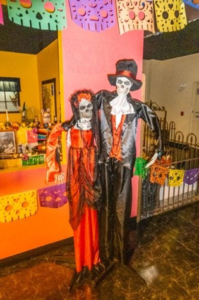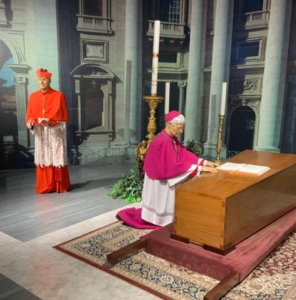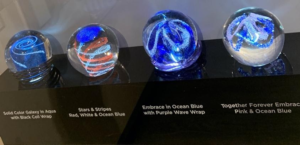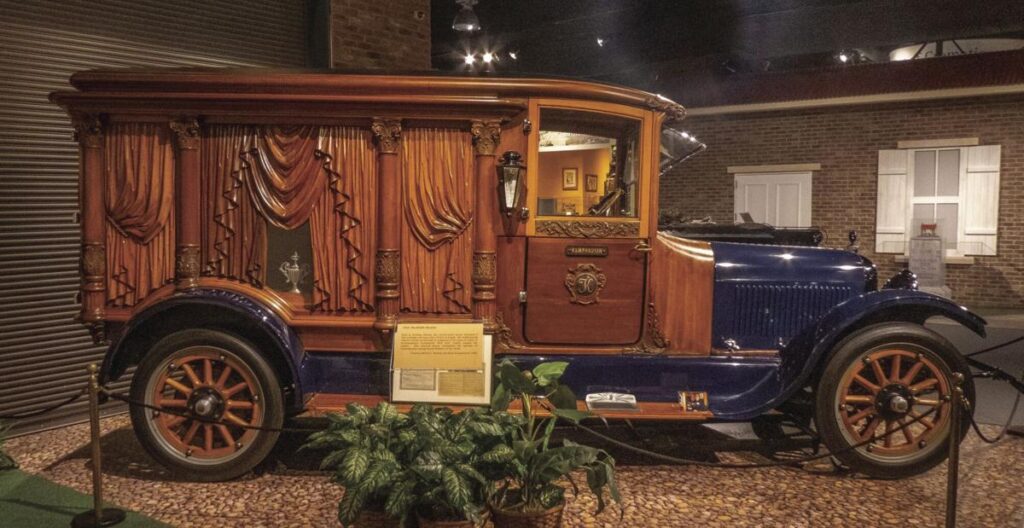Uncommon hearses, “people” in caskets, spiritual memorabilia, and special funeral displays may sound macabre, but the National Museum of Funeral History presents death and dying customs and practices to give visitors the opportunity to grasp history and cultural changes.
The National Museum of Funeral History opens daily with great opportunities for family and friends to wander through displays to understand how we honor our loved ones yesterday and today. With 30,500 square feet of space, safe social distancing is easy. I found this gem accidentally.
A friend mentioned the museum to my husband and me, when we headed from Dallas to Houston to visit grandkids about five years ago. When I saw a brochure about it on a rack by the door of our motel, we jumped at the chance for an unusual adventure. We visited the museum that weekend.
Eighteen months ago, we moved to Houston to live near our family. I decided to write about the museum and persuaded my photographer/husband into re-visiting the museum. It’s even better.
 As you enter the museum you view intriguing, fancy hearses. Where else could you see the carriages for several of our Presidents, plus antique trucks and wagons for everyday burial transportation? If I were judging the hearses for their artistry, I would choose the carved wooden carriage. I cannot fathom the time and effort to sculpt the exquisite results.
As you enter the museum you view intriguing, fancy hearses. Where else could you see the carriages for several of our Presidents, plus antique trucks and wagons for everyday burial transportation? If I were judging the hearses for their artistry, I would choose the carved wooden carriage. I cannot fathom the time and effort to sculpt the exquisite results.
Fifteen permanent displays delight and educate the visitors with realistic dioramas, replicas, and artifacts about past times. From the Popes, Abraham Lincoln, and George H.W. Bush, visitors’ reactions range from surprise to nostalgia. Another area, called “Thanks for the Memories,” is dedicated to actors, singers, and other deceased stars, including Lassie.
 If you want a venue that provides more than pumpkins in a field this fall, the Funeral Museum is the spot. A special display creates All Saints Day, Halloween, and Dia de los Muertos to celebrate various cultural folklore. You and the kids will not forget it. There is something for everyone, including a gift shop, but nothing gory. Unique? Yes. Scary? I think not. A mockup of a Mexican home on Dia de los Muertos, offers vivid colors and a skeleton couple, La Catrina and her novio (boyfriend).
If you want a venue that provides more than pumpkins in a field this fall, the Funeral Museum is the spot. A special display creates All Saints Day, Halloween, and Dia de los Muertos to celebrate various cultural folklore. You and the kids will not forget it. There is something for everyone, including a gift shop, but nothing gory. Unique? Yes. Scary? I think not. A mockup of a Mexican home on Dia de los Muertos, offers vivid colors and a skeleton couple, La Catrina and her novio (boyfriend).
The President of the museum, Genevieve Keeney, started her career with the museum in 2007 about the time their Papal exhibit began to evolve. The project snow-balled from a small 10×10 space to a massive display explaining the “Lives and Deaths of the Popes” and the “Making of a Saint.” The museum worked with the Vatican to capture realistic scenes from Rome. She asks the public to, “Come with an open mind and realize each person responds in a different way.” The Papal exhibit has expanded to a mammoth walk through history. The backgrounds, robes, and tombs help you imagine you are actually in Rome.

My curiosity got the best of me: how did Genevieve Keeney become the President of this prestigious organization? Her story takes her from inquisitive child to becoming a medic in the Army where she dealt with life and death situations. After twelve years in the Army, she researched good paying jobs where her skills and interests would fit. Her new, part-time job led her to Palliative Care at the Veterans Administration Medical Center in Houston. She loved it and returned to college where she completed a Masters in Science in Organizational Management. She became a volunteer at the museum. “The people around me recognized my passion for the museum. My creativity and diligence paid off. I became involved with the Papal display, helping make it what it is today.”
I asked Ms. Keene about the history of the museum. Robert Waltrip, a funeral home owner in Texas, thought about starting a museum long before the reality of the National Museum of Funeral History developed. His company, Service Company International, grew across North America. He added more funeral homes, cemeteries and cremation. He realized the need to keep treasures from the past in a museum. His first effort established a small non-profit museum in 1992, which has developed into an American icon for dignity in death.
Today his company has a new owner, is publicly traded, and serves over 450,000 families a year. Waltrip’s former company oversees forty locations for cremation and 1900 locations in forty-five states and eight provinces in Canada. Service Company International owns 40 crematories with 25,000 associates. Although Robert has retired, one of his sons remains on the Board of the museum, as Treasurer.
You can see the exhibit of the first building for cremation, called a “retort” where high, intense flames render the body to “ashes.” A display of subdued and colorful urns decks the wall near the crematory information.
Recently, people have begun asking glass artists to encase a small amount of remains or “ashes” of loved ones (including pets) into shiny, glass paperweights. Some clear, some with color added. In a conversation with Chris Sherwin, a well-known glass paperweight artist, he said, “This is not a fad. In the past four years I’ve made 1000 paperweights for families.” And that’s part-time work for him, as he concentrates on other glass art.
The urns outnumber the paperweights in the museum and elsewhere, but with more and more cremations the paperweights and jewelry are becoming more popular. The museum has several demonstration paperweights and pendants for you to see.

According to an article on CNN from the National Funeral Directors Association, cremation is the top request from those who die this year. Statistics indicate cremation will continue to grow.
Another fascinating exhibit to visit shows artwork by Heide Hatry who created a technique using human remains to “paint” lifelike portraits of the deceased. She determined the different shades of gray and embedded the particles in beeswax. A small room filled with her portraits amazes viewers.
Be sure to visit the gift shop, which sells related fun and fancy items for everyone who visits. I bought my husband one of the T-shirts. When people ask him, “How ya’ doing?” He often responds, “I’m above ground.” That t-shirt and other novelties made me laugh. Do you want koozies or facemasks, skeletons or religious items? Both adults and kids can find trinkets to purchase.
No ghosts are allowed, but memorable moments exist for the entire family. Fall is the perfect time to learn more about the National Museum of Funeral History, which is located at 415 Barren Springs Drive on the north side of Houston, near Interstate 45 and FM 1960. Tickets range from $7-11, depending on your age. I suggest a minimum of two hours to wander through displays, but you may want to allow longer with the number of thought-provoking exhibits and astounding history.
By: Ruth Glover, Freelance Writer and Author
Photos by: T. Glover
